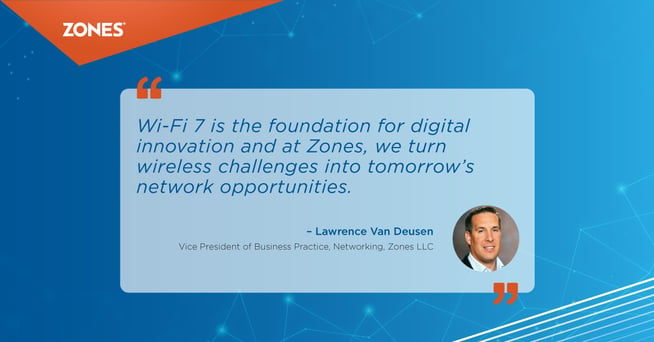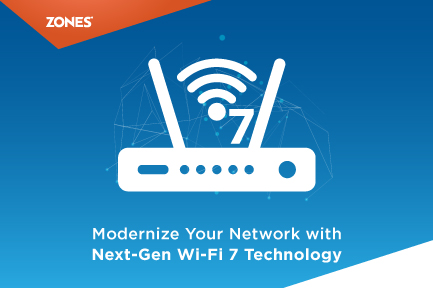A New Era of Wireless Possibilities
As the digital-first economy continues to advance at increasingly breakneck speeds, businesses are rapidly changing their network architecture to meet rising expectations for fast data, hyper-connectivity, and real-time collaboration. Leading the charge is Wi-Fi 7, the strongest wireless standard yet. Unveiled in January 2024, Wi-Fi 7 (IEEE 802.11be or Extremely High Throughput) will revolutionize the operating, innovative, and scaling capabilities of contemporary business.
With capabilities like up to 30 Gbps speed, ultra-low latency, and support for demanding applications such as AR, VR, and AI-driven workloads, Wi-Fi 7 is not just an upgrade—it’s a reinvention. In this blog, we explore how Wi-Fi 7 drives network modernization, the industry metrics validating its need, the challenges customers face, the unique benefits it delivers, and best practices for implementation.
The Metrics Driving Momentum
The rapid evolution of connected environments has intensified the need for more powerful, scalable, and intelligent networking. Wi-Fi 7 is engineered to respond to this shift.
By 2025, over 85% of enterprises are projected to have more unmanaged devices on their networks than managed ones. The surge in AI-driven applications is another force multiplier—37% of CIOs report that increased network demand from AI is significantly influencing their strategy.
Wi-Fi 7 outpaces its predecessor in every major metric. It supports up to 320 MHz channels (a 100% increase from Wi-Fi 6), offering maximum data rates of approximately 30 Gbps, a staggering 213% improvement. With 4096-QAM (Quadrature Amplitude Modulation), it enhances spectral efficiency and increases the data encoded per signal. These capabilities aren’t just theoretical—they are necessary for environments with high data throughput, real-time analytics, and immersive digital experiences.
Real-World Challenges Enterprises Face
-
Resilience and Scalability Gaps:
Despite technological advancements, many organizations find it challenging to maintain resilient, scalable, and secure connectivity.
-
Mission-Critical Demands:
Industries such as healthcare, manufacturing, education, and transportation require uninterrupted access to data. Network disruptions—such as dropped packets or latency—can lead to productivity loss, safety risks, or service outages.
-
Inadequate Performance from Legacy Networks:
Traditional networks often lack the low latency and high availability necessary to support real-time, mission-critical operations.
-
Device and Application Growth:
The rapid increase in connected devices, applications, and users contributes to network congestion and performance degradation.
-
Complex Network Ecosystems:
Managing LAN and WAN environments simultaneously has become increasingly complex, particularly with the convergence of IT and OT systems.
-
Lack of End-to-End Visibility:
Many organizations struggle with limited network visibility, resulting in higher risk exposure, reduced efficiency, and increased operational costs.
The Benefits of Wi-Fi 7 for Network Modernization
Wi-Fi 7 delivers tangible outcomes that elevate operational agility and digital transformation.
-
AI-Native Optimization:
Wi-Fi 7 intelligently configures each environment—whether high-density indoor spaces or rugged outdoor areas—for peak performance by dynamically adjusting radio settings using historical RF data.
-
Seamless Deployment:
Access points support hybrid management (on-premises, cloud, or both), enable automatic regional compliance detection, and include built-in location services—simplifying deployment and scalability.
-
Enhanced Scalability and Innovation Support:
The architecture supports IoT infrastructure and advanced use cases such as smart buildings and predictive maintenance, enabling organizations to drive innovation at scale.
-
Advanced Security Capabilities:
Features like AI-native device profiling, automated policy enforcement, enhanced threat prevention, and built-in wireless intrusion protection help maintain robust, end-to-end security in Zero Trust environments.
What Sets Wi-Fi 7 Apart—Key Differentiators
-
Unified Licensing Model:
Wi-Fi 7 supports a global deployment model with a single product ID (PID), eliminating the need to manage regional domain constraints and enabling more efficient hardware procurement.
-
Decoupled Hardware and Software Lifecycle:
Organizations can manage hardware purchases independently from software licensing, reducing vendor lock-in and streamlining upgrade cycles.
-
Proprietary Quad-Radio Architecture:
Equipped with four radios, including a dedicated scanning radio, Wi-Fi 7 access points deliver superior RF optimization and enhanced security without degrading user experience.
-
Ultra-Reliable Wireless Backhaul:
Ensures seamless connectivity and low-latency handoffs, essential for mission-critical environments such as healthcare and industrial automation.
-
Backward Compatibility:
Supports existing mounting infrastructure and hardware elements, enabling efficient, cost-effective upgrades with minimal physical modifications.
Things to Consider as You Plan to Adopt Wi-Fi 7
While Wi-Fi 7 promises transformative gains in performance and efficiency, enterprises should be aware of several practical considerations before adopting the new standard:
-
Reduced Range and Signal Penetration:
Wi-Fi 7’s higher-frequency channels may result in reduced range and lower signal penetration compared to previous standards. This can be a limiting factor in environments with physical obstructions or large coverage areas, requiring strategic access point placement or additional infrastructure to maintain coverage.
-
Compatibility Limitations:
Device availability remains limited in the early stages of Wi-Fi 7 adoption. Businesses may face compatibility challenges, especially in environments with a mix of legacy and next-gen devices. A phased deployment strategy may help mitigate these issues.
-
Infrastructure Readiness:
Upgrading to Wi-Fi 7 isn't just about replacing access points. Supporting its full capabilities may require enhancements to your existing network infrastructure, including switching hardware, cabling, and power capacity to handle the increased data throughput.
-
Complexity of the Upgrade Process:
Transitioning to Wi-Fi 7 can be complex and potentially disruptive. Businesses that rely on uninterrupted connectivity must plan carefully to minimize downtime and ensure a seamless migration. Proper assessment and staging are essential to manage the upgrade with minimal operational impact.
By addressing these factors early in your planning process, you can ensure a smoother, more effective Wi-Fi 7 rollout that maximizes value while minimizing risk.
Best Practices for Implementing Wi-Fi 7
-
Strategic Alignment:
- Ensure adoption plans align with overall business objectives and involve cross-functional collaboration across IT, operations, and leadership teams.
-
Conduct a Comprehensive Network Assessment:
- Evaluate your current infrastructure, device ecosystem, and workload requirements.
- Identify areas with limited coverage, network congestion, or performance bottlenecks.
- Use insights from the assessment to design a use case-driven deployment roadmap.
-
Invest in Future-Ready Infrastructure:
- Choose modular, scalable hardware to accommodate evolving network needs.
- Confirm that your switching infrastructure can support Wi-Fi 7’s high throughput and power demands.
- Consider hybrid management capabilities to enable flexibility between on-premises and cloud environments.
-
Prioritize Security from the Outset:
- Deploy AI-powered threat detection, real-time monitoring, and dynamic device profiling.
- Educate teams on Wi-Fi 7’s advanced security features and operational tools.
- Establish automated remediation workflows to ensure rapid and efficient incident response.
Zones' Role in Network Modernization with Wi-Fi 7
At Zones, we help enterprises transform their wireless environments into agile, secure, and intelligent networks with Wi-Fi 7 at the core. Our comprehensive approach spans the full IT lifecycle—Assess, Design, Implement, and Manage (ADIM).
During the Assess phase, we identify existing gaps, performance limitations, and alignment with business goals. In the Design stage, our experts craft a scalable and secure wireless architecture tailored to your use cases. Our Implement services ensure seamless deployment with minimal disruption, leveraging our deep partnerships with OEMs. Finally, through our Manage offerings, we provide continuous monitoring, analytics, and optimization to maximize ROI and minimize risk.
By integrating Wi-Fi 7 into your network strategy, we enable your enterprise to:
- Support hybrid work and real-time collaboration
- Secure data across every endpoint
- Enable IoT and smart space innovation
- Scale your infrastructure for tomorrow’s demands

Your Next Step Toward Wireless Transformation
Wi-Fi 7 is not just a technological upgrade—it is the foundation for next-generation connectivity that supports business agility, innovation, and resilience. With significantly higher speeds, increased spectrum efficiency, and native AI and security capabilities, Wi-Fi 7 empowers organizations to meet today’s demands and tomorrow’s challenges.
Modernizing your network with Wi-Fi 7 ensures that your infrastructure can support digital transformation initiatives without compromise. However, technology is only one part of the equation—expertise in implementation and lifecycle management is equally critical.
With Zones as your strategic partner, you can confidently navigate this journey. We provide the tools, services, and expertise to ensure that your wireless transformation delivers measurable outcomes. Let’s modernize your network—intelligently, securely, and efficiently—with Wi-Fi 7.
*Source: Cisco Networking Guide 2025
A New Era of Wireless Possibilities
As the digital-first economy continues to advance at increasingly breakneck speeds, businesses are rapidly changing their network architecture to meet rising expectations for fast data, hyper-connectivity, and real-time collaboration. Leading the charge is Wi-Fi 7, the strongest wireless standard yet. Unveiled in January 2024, Wi-Fi 7 (IEEE 802.11be or Extremely High Throughput) will revolutionize the operating, innovative, and scaling capabilities of contemporary business.
With capabilities like up to 30 Gbps speed, ultra-low latency, and support for demanding applications such as AR, VR, and AI-driven workloads, Wi-Fi 7 is not just an upgrade—it’s a reinvention. In this blog, we explore how Wi-Fi 7 drives network modernization, the industry metrics validating its need, the challenges customers face, the unique benefits it delivers, and best practices for implementation.
The Metrics Driving Momentum*
The rapid evolution of connected environments has intensified the need for more powerful, scalable, and intelligent networking. Wi-Fi 7 is engineered to respond to this shift.
By 2025, over 85% of enterprises are projected to have more unmanaged devices on their networks than managed ones. The surge in AI-driven applications is another force multiplier—37% of CIOs report that increased network demand from AI is significantly influencing their strategy.
Wi-Fi 7 outpaces its predecessor in every major metric. It supports up to 320 MHz channels (a 100% increase from Wi-Fi 6), offering maximum data rates of approximately 30 Gbps, a staggering 213% improvement. With 4096-QAM (Quadrature Amplitude Modulation), it enhances spectral efficiency and increases the data encoded per signal. These capabilities aren’t just theoretical—they are necessary for environments with high data throughput, real-time analytics, and immersive digital experiences.
Real-World Challenges Enterprises Face
-
Resilience and Scalability Gaps:
Despite technological advancements, many organizations find it challenging to maintain resilient, scalable, and secure connectivity.
-
Mission-Critical Demands:
Industries such as healthcare, manufacturing, education, and transportation require uninterrupted access to data. Network disruptions—such as dropped packets or latency—can lead to productivity loss, safety risks, or service outages.
-
Inadequate Performance from Legacy Networks:
Traditional networks often lack the low latency and high availability necessary to support real-time, mission-critical operations.
-
Device and Application Growth:
The rapid increase in connected devices, applications, and users contributes to network congestion and performance degradation.
-
Complex Network Ecosystems:
Managing LAN and WAN environments simultaneously has become increasingly complex, particularly with the convergence of IT and OT systems.
-
Lack of End-to-End Visibility:
Many organizations struggle with limited network visibility, resulting in higher risk exposure, reduced efficiency, and increased operational costs.
The Benefits of Wi-Fi 7 for Network Modernization
Wi-Fi 7 delivers tangible outcomes that elevate operational agility and digital transformation.
-
AI-Native Optimization:
Wi-Fi 7 intelligently configures each environment—whether high-density indoor spaces or rugged outdoor areas—for peak performance by dynamically adjusting radio settings using historical RF data.
-
Seamless Deployment:
Access points support hybrid management (on-premises, cloud, or both), enable automatic regional compliance detection, and include built-in location services—simplifying deployment and scalability.
-
Enhanced Scalability and Innovation Support:
The architecture supports IoT infrastructure and advanced use cases such as smart buildings and predictive maintenance, enabling organizations to drive innovation at scale.
-
Advanced Security Capabilities:
Features like AI-native device profiling, automated policy enforcement, enhanced threat prevention, and built-in wireless intrusion protection help maintain robust, end-to-end security in Zero Trust environments.
What Sets Wi-Fi 7 Apart—Key Differentiators
-
Unified Licensing Model:
Wi-Fi 7 supports a global deployment model with a single product ID (PID), eliminating the need to manage regional domain constraints and enabling more efficient hardware procurement.
-
Decoupled Hardware and Software Lifecycle:
Organizations can manage hardware purchases independently from software licensing, reducing vendor lock-in and streamlining upgrade cycles.
-
Proprietary Quad-Radio Architecture:
Equipped with four radios, including a dedicated scanning radio, Wi-Fi 7 access points deliver superior RF optimization and enhanced security without degrading user experience.
-
Ultra-Reliable Wireless Backhaul:
Ensures seamless connectivity and low-latency handoffs, essential for mission-critical environments such as healthcare and industrial automation.
-
Backward Compatibility:
Supports existing mounting infrastructure and hardware elements, enabling efficient, cost-effective upgrades with minimal physical modifications.
Things to Consider as You Plan to Adopt Wi-Fi 7
While Wi-Fi 7 promises transformative gains in performance and efficiency, enterprises should be aware of several practical considerations before adopting the new standard:
-
Reduced Range and Signal Penetration:
Wi-Fi 7’s higher-frequency channels may result in reduced range and lower signal penetration compared to previous standards. This can be a limiting factor in environments with physical obstructions or large coverage areas, requiring strategic access point placement or additional infrastructure to maintain coverage.
-
Compatibility Limitations:
Device availability remains limited in the early stages of Wi-Fi 7 adoption. Businesses may face compatibility challenges, especially in environments with a mix of legacy and next-gen devices. A phased deployment strategy may help mitigate these issues.
-
Infrastructure Readiness:
Upgrading to Wi-Fi 7 isn't just about replacing access points. Supporting its full capabilities may require enhancements to your existing network infrastructure, including switching hardware, cabling, and power capacity to handle the increased data throughput.
-
Complexity of the Upgrade Process:
Transitioning to Wi-Fi 7 can be complex and potentially disruptive. Businesses that rely on uninterrupted connectivity must plan carefully to minimize downtime and ensure a seamless migration. Proper assessment and staging are essential to manage the upgrade with minimal operational impact.
By addressing these factors early in your planning process, you can ensure a smoother, more effective Wi-Fi 7 rollout that maximizes value while minimizing risk.
Best Practices for Implementing Wi-Fi 7
-
Strategic Alignment:
Ensure adoption plans align with overall business objectives and involve cross-functional collaboration across IT, operations, and leadership teams.
-
Conduct a Comprehensive Network Assessment:
- Evaluate your current infrastructure, device ecosystem, and workload requirements.
- Identify areas with limited coverage, network congestion, or performance bottlenecks.
- Use insights from the assessment to design a use case-driven deployment roadmap.
-
Invest in Future-Ready Infrastructure:
- Choose modular, scalable hardware to accommodate evolving network needs.
- Confirm that your switching infrastructure can support Wi-Fi 7’s high throughput and power demands.
- Consider hybrid management capabilities to enable flexibility between on-premises and cloud environments.
-
Prioritize Security from the Outset:
- Deploy AI-powered threat detection, real-time monitoring, and dynamic device profiling.
- Educate teams on Wi-Fi 7’s advanced security features and operational tools.
- Establish automated remediation workflows to ensure rapid and efficient incident response.
Zones' Role in Network Modernization with Wi-Fi 7
At Zones, we help enterprises transform their wireless environments into agile, secure, and intelligent networks with Wi-Fi 7 at the core. Our comprehensive approach spans the full IT lifecycle—Assess, Design, Implement, and Manage (ADIM).
During the Assess phase, we identify existing gaps, performance limitations, and alignment with business goals. In the Design stage, our experts craft a scalable and secure wireless architecture tailored to your use cases. Our Implement services ensure seamless deployment with minimal disruption, leveraging our deep partnerships with OEMs. Finally, through our Manage offerings, we provide continuous monitoring, analytics, and optimization to maximize ROI and minimize risk.
By integrating Wi-Fi 7 into your network strategy, we enable your enterprise to:
- Support hybrid work and real-time collaboration
- Secure data across every endpoint
- Enable IoT and smart space innovation
- Scale your infrastructure for tomorrow’s demands
Your Next Step Toward Wireless Transformation
Wi-Fi 7 is not just a technological upgrade—it is the foundation for next-generation connectivity that supports business agility, innovation, and resilience. With significantly higher speeds, increased spectrum efficiency, and native AI and security capabilities, Wi-Fi 7 empowers organizations to meet today’s demands and tomorrow’s challenges.
Modernizing your network with Wi-Fi 7 ensures that your infrastructure can support digital transformation initiatives without compromise. However, technology is only one part of the equation—expertise in implementation and lifecycle management is equally critical.
With Zones as your strategic partner, you can confidently navigate this journey. We provide the tools, services, and expertise to ensure that your wireless transformation delivers measurable outcomes. Let’s modernize your network—intelligently, securely, and efficiently—with Wi-Fi 7.
*Source: Cisco Networking Guide 2025




